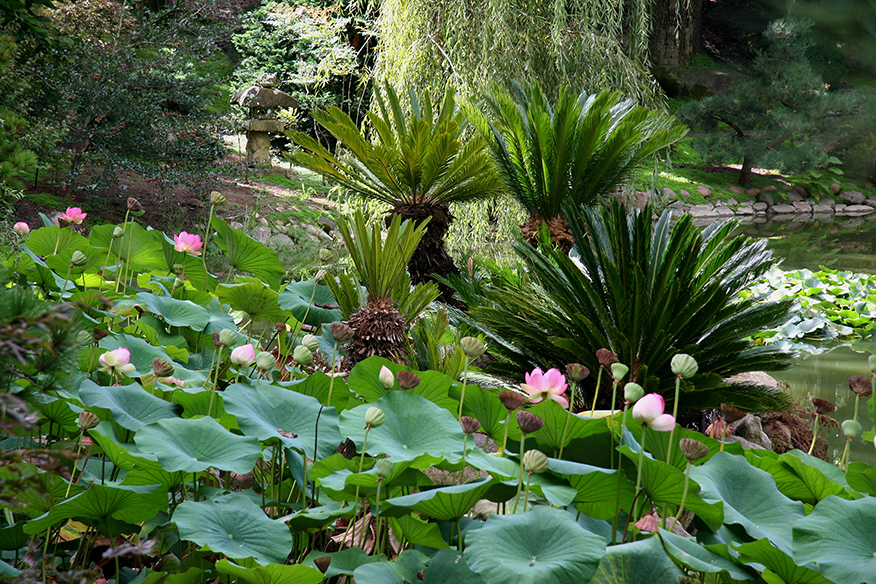Lotusland aims to preserve the estate of Madame Ganna Walska and to care for the impressive gardens that she created over the course of her life. The staff members at Lotusland have worked hard to develop sustainable horticulture programs. They remain dedicated to educating the general public about the importance of plants to life on this planet and how to create their own sustainable gardens.
The gardeners at Lotusland take a natural and holistic approach to gardening and use products that support the rich biodiversity found in the soil. Some of the basic products they use include fertilizer, compost, mulches, and organic fertilizers made from soybeans, fish, kelp, and alfalfa. To share its practices with the public, Lotusland makes a wide range of sustainable gardening advice available on its website, Lotusland.org. According to the organization, sustainable gardens depend on the following four primary principles:
1. Control pests by building a diverse insect ecology. Instead of relying on harmful pesticides to control pests, gardeners can simply increase the number and variety of insects in the garden. While actively increasing the number of bugs present may seem counterintuitive, attracting the right kind of insects keeps harmful ones at bay. In general, native plants are best for attracting beneficial insects and providing them with the pollen, nectar, and habitat that they need to survive. Predatory insects protect the garden against invasive bugs while also serving as a source of food for other animals that protect the garden, including lizards and birds.
2. Rely on compost and mulches to return nutrients to the garden. Compost is a natural way of improving soil conditions by introducing new organisms, feeding existing ones, and maximizing moisture retention. Derived from natural decomposition processes, compost is a constructive form of nutrient recycling. Applying a layer of organic mulch on top of the garden helps to protect the ground. Mulches discourage weed growth, help retain moisture in the soil, and minimize erosion. As mulch breaks down, it serves a similar purpose to compost and improves soil conditions.
3. Focus on the organism in the soil. When gardeners support the organisms already living in soil, those organisms will produce food for the plants. These organisms feed on various organic compounds and, in the process, break them down into nutrients that plants can then extract from the soil. Chemical fertilizers provide only a temporary source of food for plants, while simultaneously sterilizing the soil. By supporting existing organisms, gardeners create a robust ecosystem that continues to support plant life into the future. Organic fertilizers contribute to biodiversity and help balance nutrient levels throughout the year. In addition, organic compounds minimize plant disease. Gardeners only need to use organic fertilizers once or twice annually to keep a garden strong.
4. Avoid chemical pesticides at all costs. Chemical pesticides do indeed kills pests, but they also destroy the delicate garden ecosystem. In addition, they wipe out beneficial insects, leaving the garden vulnerable. A garden’s biological balance can be disturbed by even a small amount of pesticide, which kills many of the organisms in the soil that feeds plants. Gardeners can instead rely on holistic approaches to pest control, such as compost teas, which combat fungal diseases and strengthen plants, allowing them to fight off infestations when they do occur. Compost teas offer a film of living organisms on the leaf that protect against harmful disease pathogens.
Alongside these principles, Lotusland offers a number of other strategies for maintaining a garden’s health depending on the particular situation at hand. These tips include:
1. Tool sanitation. Sanitizing tools, boots, and machinery between uses can reduce the spread of disease among plants. Gardeners at Lotusland use standard disinfectant procedures whenever they deal with susceptible plants. A light spray of WD-40 can prevent the corrosion of tools, which can also harm the garden ecosystem.
2. Lawn clippings. After mowing the lawns, finely chopped grass can be returned to the grassy areas to decompose, a process that provides key nutrients needed for plant growth. The clippings could be spread in gardens or other areas rather than being kept in the lawn.
3. Supplemental drainage. If particular plants are prone to root rot, supplemental drainage installation can remove excessive water around root systems and help to maintain ideal moisture levels. Root health relies on sub-surface draining, mulching, and maintaining healthy soil.
4. Minimal maintenance. Typical maintenance procedures, ranging from trimming back plants to raking soil, all impact the ecosystem of a garden. Walking through flowerbeds, blowing leaves, and otherwise impacting the garden can have a negative effect on the entire ecosystem. While maintenance is necessary to keep gardens presentable, gardeners should create a plan that has the lowest impact possible.
5. Weed management. The manual removal of weeds should be the primary defense against invasive plants. When gardeners mulch gardens extensively, they prevent most weeds from spreading. If necessary, organic herbicide can be used to discourage weed growth in graveled areas, but care should be taken not to introduce these products into the garden soil.
